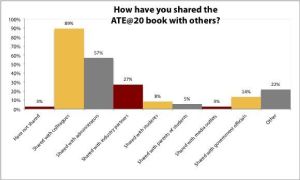
ATE@20: Two Decades of Advancing Technological Education offers a glimpse into the discoveries and opportunities generated by Advanced Technological Education projects and centers during the past two decades.
A recent survey of readers found that in the four months after the book was released at the ATE Principal Investigators Conference in October 2013, its content has been reused and shared to reach key audiences beyond the ATE community.
ATE Central's goals for the publication and its companion ATE@20 blog include informing students and their relatives about science, technology, engineering, and math (STEM) career opportunities; directing educators to ATE resources and professional development opportunities; and facilitating ATE principal investigators' connections with potential industry partners.
Single and multiple copies of the free book are available by emailing ate20@atecentral.net.
Book Explains ATE to Multiple Audiences
Student innovations and successes are a pivotal indicator of ATE’s impact on community and technical college education throughout the past 20 years. To highlight these accomplishments, the book contains human interest stories about ATE program graduates like Casey Kraus, who "loves" her work as a nuclear power technician; Jennifer Keelan Lazar, who has mentored two generations of biotechnology teachers in Texas; and Jennifer Robles Chancellor, who applied what she learned during an ATE internship to win two top undergraduate science prizes and to pursue a PhD.
Faculty members, like Mike Rudibaugh of Lake Land College, Illinois, are featured, too. Rudibaugh leveraged the mentoring he received through MentorLinks—an ATE project led by the American Association of Community Colleges—into a national professional network that supports the expansion of geospatial education programs to meet employers' needs in Central Illinois.
The book summarizes the history of the ATE program and milestones since 1992 when Congress passed the Scientific and Advanced Technology Act, the legislation that led to the National Science Foundation's creation of the ATE program.
Dynamic national, regional, statewide, and cross-discipline initiatives are profiled in the book. ATE's robust industry partnerships, transformation of STEM education at two-year colleges, and collaborations with other education sectors are covered as well.
Infographics created by graphic artists at the University of Wisconsin-Madison are used throughout the book to illustrate key data about the ATE program and its cultivation of ingenious technical workers whose knowledge, skills, talents, and abilities are shaping the nation's economic future.
ATE@20 Survey Results
A majority of the survey respondents found the book useful. Fifty-seven percent of them listed the book as "very useful" and 38 percent found the book somewhat useful. ATE Central will continue to gather feedback in the coming months, and Principal Investigator Rachael Bower encourages anyone who has read the book to participate in the survey at https://atecentral.net/ate20survey.
Nearly half of the people who responded to the ATE@20 usage survey (which was sent in February to people who requested and received copies of the book) reported that they had used portions of the book in presentations, promotional materials, social media posts, newsletters, or blogs.
Most of the respondents (65%) are ATE project or center principal investigators. Others who participated in the survey include community college educators who do not have ATE grants, community college administrators, ATE project or center staff members, high school guidance counselors, and a member of an ATE national visiting committee.
Comments shared by survey respondents include
- "The ATE@20 book is a professional work that is graphically appealing and well written."
- "It seems to me all the content there could be derivatized into other things as well."
- "I shared the book with members of [our] Academic Council. They were impressed with the featured projects. The book supplies us with names of schools to research for guidance for our own endeavors."
- "Great Promotional Book. We have given it to 25 area high schools, as well as high school parents, letting them know about ATE opportunities."
The Internet Scout Research Group published the ATE@20 book and blog with support from the National Science Foundation. Internet Scout, a research center at the University of Wisconsin-Madison, created and maintains ATE Central. It is a freely available online portal and collection of materials and services that highlight the work of ATE projects and centers.

 Subscribe
Subscribe


 See More ATE Impacts
See More ATE Impacts

Comments
There are no comments yet for this entry. Please Log In to post one.